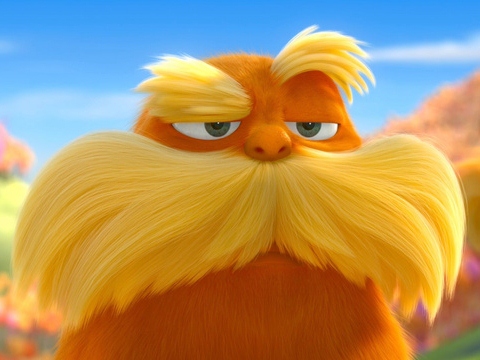
Screenwriters Cinco Paul and Ken Daurio say the films they watched as children weren’t always soft and cuddly in nature. They wouldn’t have it any other way then – or now.
“We coddle kids,” Daurio tells Big Hollywood. “When you step back and look at entertainment geared for kids,so much of it is watered down … kids can handle more than you think they can.”
That thinking influenced Paul and Daurio as they prepared the screenplay for the new animated feature “Dr. Seuss’ The Lorax.”
The film, based on the beloved author’s 1971 environmental tome, tells of what happens when a young entrepreneur ignores a fantastical creature out to protect the environment. What emerges is a world without the cotton candy Truffula trees born from Dr. Seuss’ vibrant imagination.
“There is a melancholy tone to a lot of the book. It’s looking back at the world as it was and as it is after the Once-ler ruined everything,” Paul says. “That’s a huge part of what makes the book work. But we also wanted to be true to the note of hope in the book.”
“Dr. Seuss wasn’t afraid to talk to kids like they could handle that,” Daurio adds. “We keep that spirit alive. We’re not making a movie just for kids. It’s something we want to see.”
And keeping the author’s pro-environmental message alive meant risking the alienation of some adult audience members not interested in a candy colored sermon.
The filmmakers were willing to take that chance.
“We felt the message was so important it transcended politics,” Paul says. “This world is a beautiful place, and we need to appreciate it and take care of it, put all of our energy into that,” Paul says.
The screenwriters first tackled a Dr. Seuss story with the 2008 animation film “Horton Hears a Who!” Daurio’s favorite book by the late author. For their second Seussian adventure, the team turned to Paul’s preferred Seuss saga.
Paul remembers seeing a statue of the Lorax in the backyard of Audrey Geisel, the author’s widow, and pining to bring the creature to life on the big screen.
To do so, the screenwriters had to get into Seuss’ mindset since “The Lorax” story wraps in 72 pages.
“You go back to the book and the answers are there… it’s right there in the background,” Paul says. “‘Horton’ lent itself more easily to the three-act structure. This didn’t.”
What came more naturally was casting Danny DeVito to voice the Lorax.
“Danny DeVito is an animated character,” Daurio says. “He literally flips a switch and he goes. You just stand back … once we stumbled across Danny’s name we couldn’t think of any other name [for the part].”
Audiences will have the final say in whether Daurio and Paul properly leveraged the Dr. Seuss classic or added something unnatural to the original tale. Either way, they don’t mind if children leave the theater having felt … something … from their adaptation.
“The moment [in the book] when the Lorax bleeds haunted me as a kid. When I saw the completed version, it was amazing. My favorite moment in the movie is that sad look,” Paul says.

COMMENTS
Please let us know if you're having issues with commenting.